|
BMW N63 Engine Variants
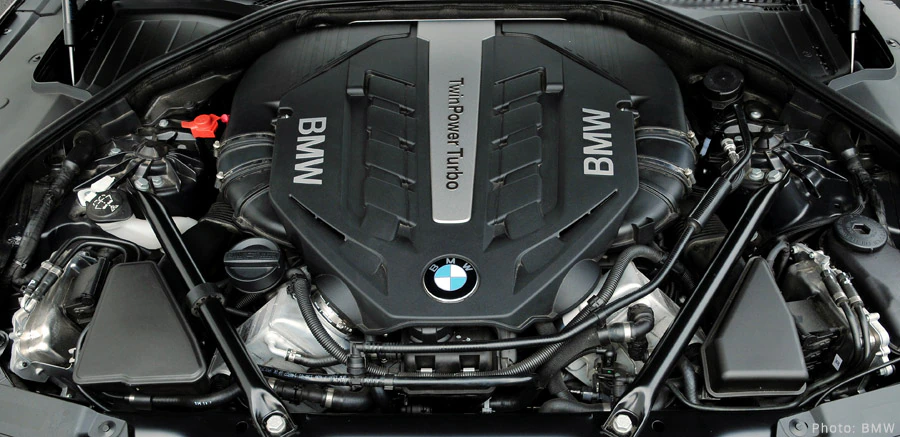
The BMW N63 is BMW's first twin-turbo V8 engine ever and debuted in the 2008 E71 X6 50i. Over time it would become the primary powerplant for all 5, 6, 7, 8-series, X5, X6, and X7 models in the BMW lineup, including M editions. While the smaller 4 and 6-cylinder engines had a major overhaul for 2016, transitioning from N-series to B-series designs, the V8 and V12 BMW engines continue on with their mid-2000s engineering. In 2022, BMW released the S68 - the biggest evolution of the original N63 hot-vee concept. Even with BMW expanding the ‘i’ brand they still plan on gasoline and mild-hybrid models for the executive and luxury class vehicles for at least the next decade.
That still leaves over 10 years of N63 engine production, one of the longest for any BMW powerplant. The N63 was flooded with problems during its lifespan, which necessitated major running changes and updates. Normally you can find this info on Wikipedia but too often that contains stale content or is not focused on the US market. We'll detail the N63 engine variants here, including Motorsport S63 editions, as even we have a hard time keeping track of them all!
Engine Code
The alphanumeric "N63" BMW engine code breaks down like this:
N = "New Generation" of BMW engines
6 = internal code for 8-cylinder engine
3 = technical design code (in this case turbocharged with Direct Injection)
B = benzine (gasoline)
44 = 4.4 liter
O = power output class (there are 7 different classes, O is for Obere or upper)
0 = version number, 0 for the original design
You can find more about BMW engine codes on our dedicated page by clicking here. BMW engine codes don't always follow their own corporate logic. The N63 should have been an N64 (Turbocharged Direct Injection with Dual VANOS) and then a transition to a N65 (Turbocharged Valvetronic Direct Injection and Dual VANOS) but it was always a N63.
N63 Model-Engine Table
| BMW Model Series | Years | Engine Long Code | Engine Short Code |
| 5 Series | |||
| 550i (F10) | 2011-2013 | N63B44O0 | N63A |
| 550i (F10) | 2014-2016 | N63B44O1 | N63TU |
| M550i (G30) | 2017-2019 | N63B44O2 | N63R, N63TU2 |
| M550i (G30) | 2020-2023 | N63B44T3 | N63B, N63T3 |
| M5 | |||
| M5 (F10) | 2012-2017 | S63B44T0 | S63TU |
| M5 (F90) | 2018-current | S63B44T4 | S63T4 |
| 6 Series | |||
| 650i (F06/F12/F13) | 2012 | N63B44O0 | N63A |
| 650i (F06/F12/F13) | 2013-2018 | N63B44O1 | N63TU |
| 7 Series | |||
| 750i/Li (F01/F02) | 2009-2012 | N63B44O0 | N63A |
| 750i/Li (F01/F02) | 2013-2015 | N63B44O1 | N63TU |
| 750i/Li (G11/G12) | 2016-2019 | N63B44O2 | N63R, N63TU2 |
| 750i/Li (G11/G12) | 2020-2022 | N63B44T3 | N63B, N63T3 |
| 760i (G70) | 2023- | S68B44T0 | S68T |
| 8 Series | |||
| M850i (G14/G15) | 2019-current | N63B44T3 | N63B, N63T3 |
| M8 (F92) | 2020-current | S63B44T4 | S63T4 |
| X5 Series | |||
| X5 xDrive50i (E70) | 2011-2013 | N63B44O0 | N63A |
| X5 xDrive50i (F15) | 2014-2017 | N63B44O1 | N63TU |
| X5 xDrive50i (G05) | 2018-current | N63B44M3 | N63M, N63M3 |
| X5 M50i (G05) | 2020-2023 | N63B44T3 | N63B, N63T3 |
| X5 M60i (G05) | 2024- | S68B44T0 | S68T |
| X5M | |||
| X5M (E70) | 2010-2013 | S63B44O0 | S63, S63A |
| X5M (F85) | 2015-2019 | S63B44T2 | S63T2 |
| X5M (F95) | 2020-2022 | S63B44T4 | S63T4 |
| X5M (F95) | 2024- | S68B44T0 | S68T |
| X6 Series | |||
| X6 xDrive50i | 2008-2013 | N63B44O0 | N63A |
| X6 xDrive50i | 2014-2019 | N63B44O1 | N63TU |
| X6 M60i (G06) | 2024- | S68B44T0 | S68T |
| X6M | |||
| X6M (E71) | 2010-2013 | S63B44O0 | S63, S63A |
| X6M (F86) | 2015-2019 | S63B44T2 | S63T2 |
| X6M (F96) | 2020-2023 | S63B44T4 | S63T4 |
| X6M (F96) | 2024- | S68B44T0 | S68T |
| X7 Series | |||
| X7 xDrive50i | 2019-2021 | N63B44M3 | N63M, N63M3 |
| X7 M50i (G07) | 2021-2022 | N63B44T3 | N63B, N63T3 |
| X7 M60i (G07) | 2023- | S68B44T0 | S68T |
| XM Series | |||
| XM / Label Red (G09) | 2022- | S68B44T0 | S68T |
N63/S63 Engine Details
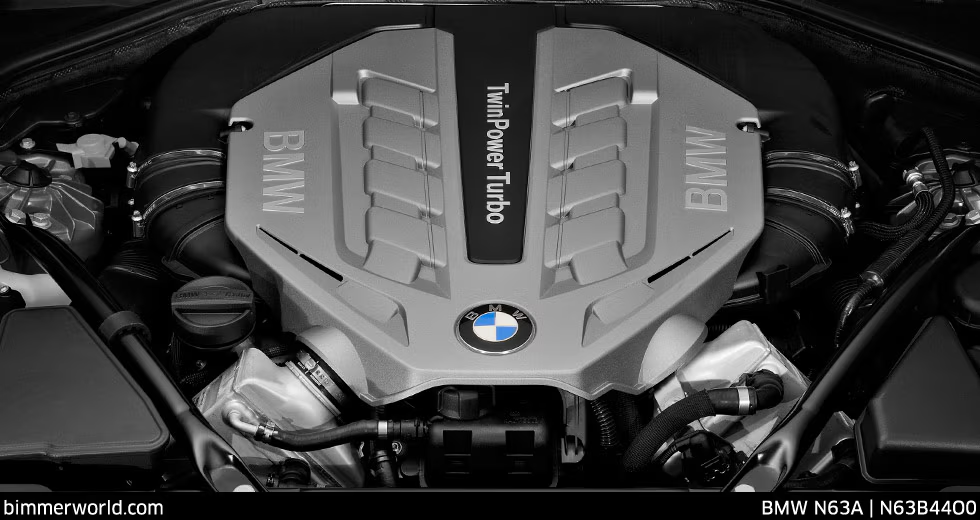
Debut / 2008 N63B44O0 (aka N63A), 402hp/443ft-lbs
The N63 is the first production turbocharged V8 engine with the turbos in the "vee" between the cylinders. They call this a "hot vee" since the exhaust and turbochargers put out tremendous heat. This puts the intakes on the outside and the exhaust on the inside, the complete opposite of most V-engines. The turbo placement is so close to the exhaust ports to reduce turbo lag and improve response. The layout is more compact and can reduce the height and profile of the car's exterior (critical for European crash regulations).
Otherwise, the N63 is pretty standard BMW technology for the time: aluminum (Alusil) block and heads, 32 valves, DOHC, VANOS variable valve timing, belt-driven accessories (including water pump), direct injection, drive-by-wire throttle, and turbochargers cooled by twin air-to-water intercoolers. All US variants, including S63 engines, are 4.4 liters. The turbos use diverter valves instead of blow-off valves, likely for "acoustic" reasons (no characteristic turbo whoosh sound).
When browsing our catalog, look for "N63A" on products that are specific to the N63B44O0 engine.
2008-2013 E71 X6 50i
2009-2012 F01/F02 750i
2010-2011 F07 550i GT
2011-2013 F10 550i
2011-2013 E70 X5 50i
2012 F12 650i
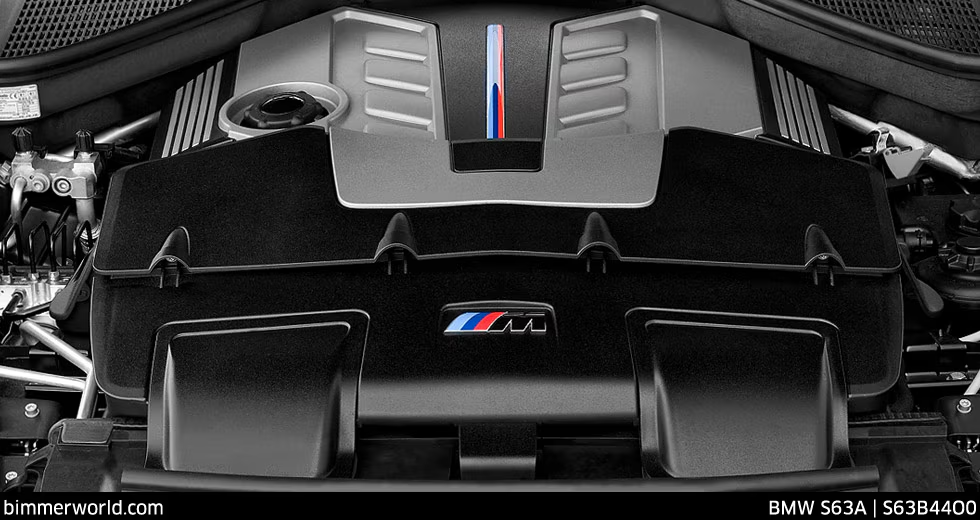
2010 S63B44O0 (aka S63A), 555hp/500ft-lbs
Significant changes were made for the S63 to make it more special than the N63: - Twin-Scroll turbochargers that greatly improves turbocharger and throttle response and reduces turbo lag. Twin-Scroll would later be added to the N63 for the N63B44O2 revision in 2016. - Higher boost pressure than the N63. - A complex tuned exhaust manifold between the cylinder head and the turbos. Every 180° of crankshaft rotation, one exhaust pulse is fed to each turbocharger over the entire ignition sequence. This makes the engine more efficient with less backpressure and better throttle response. BMW actually patented the system. - Internal changes including new pistons and different exhaust camshafts and some details of the cylinder heads are different. - Larger cooling and intake system components.
2010-2013 E70 X5M
2010-2013 E71 X6M
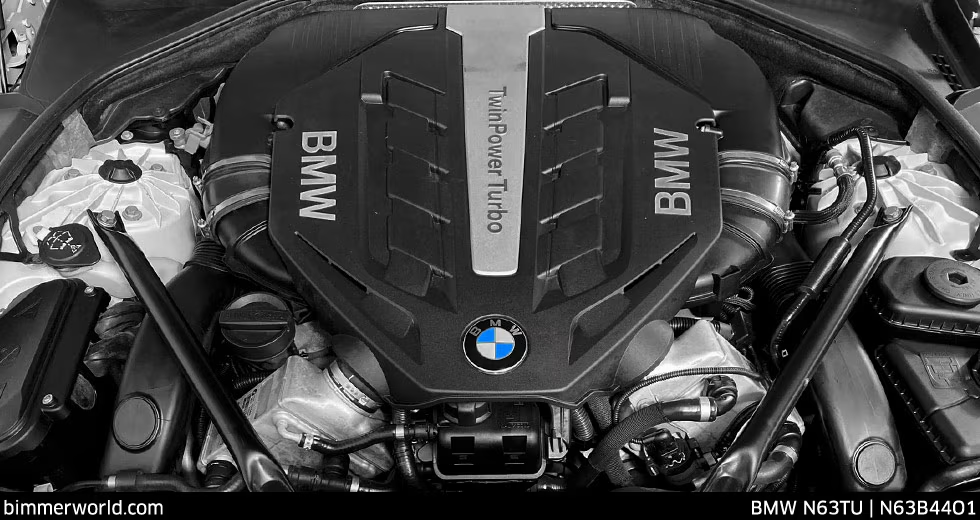
2013 N63B44O1 (aka N63TU), 444hp/480ft-lbs
The N63 was minimally revised to produce more power to match its competition. The "N63TU" nickname is an internal throwback to when BMW used the "TU" for minor engine updates. TU stands for Technical Update and is less of a mouthful than "N63B44O1".
The biggest mechanical change was moving from a drive-by-wire throttle body to the intake valve-operated Valvetronic throttle system. Primary throttle control is now done by the opening of the intake valves via an eccentric shaft in the cylinder head. This required a different cylinder head and VANOS system. The VANOS components are the same as the N55 6-cylinder. A traditional throttle body remains as a backup. Valvetronic also eliminates the need for diverter valves in the turbochargers (the intake valves now just stay open with no combustion).
Minor changes were made to the cooling system, centered around changing the shape of the expansion tank and moving it from behind the headlight to the firewall.
The valve cover was changed for the 2016 model year (from 10/2015 production). The components to the valve cover remained the same but some items, like the camshaft sensor, changed location.
A second engine computer was added so engine management is now split for each cylinder bank.
When browsing our catalog, look for "N63TU" on products that are specific to the N63B44O1 engine.
2013-2015 F01/F02 750i
2013-2016 F07 550i GT
2014-2016 F10 550i
2014-2018 F15 X5 50i
2014-2019 F16 X6 50i
2013-2018 F12/F13 650i
2013-2019 F06 650i GC
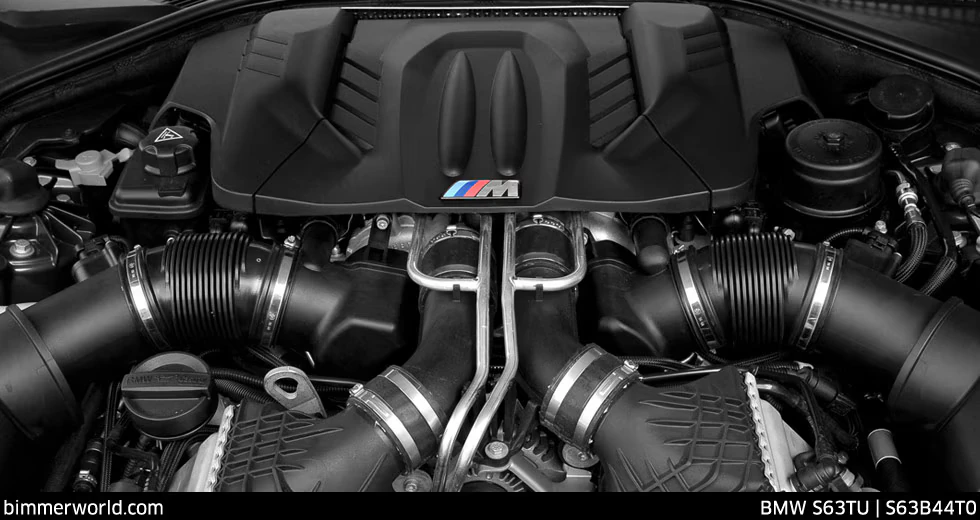
2013 S63B44T0 (S63TU), 560hp/500ft-lbs
The S63 name went from "Upper" output to "Top" output thanks to a higher compression ratio and slightly more boost. It also adopted Valvetronic throttle system that was also released for the N63TU.
The S63T0 used for the M5/M6 benefited from the same updates as the N63TU engine (see above), including Valvetronic. While the N63TU continued with the "mono-scroll" turbos the S63TU kept the Twin-Scroll design.
2013-2017 F10 M5
2013-2019 F06 M6 GC
2013-2019 F12/F13 M6
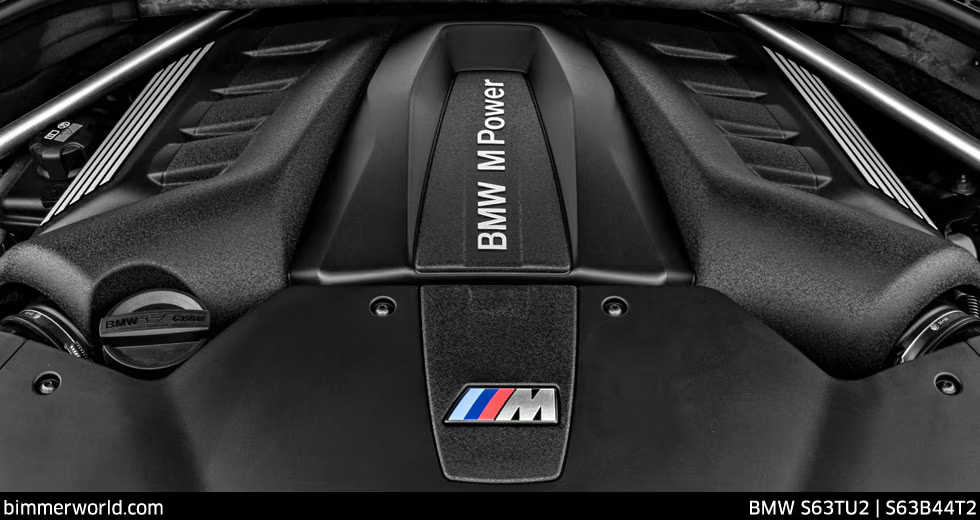
2015 S63B44T2, 567hp/553ft-lbs
BMW skipped a S63B44T1 designation. The T2 is largely based on the T0 used in the F10 M5 and F12/F13 M6, which draws a lot of construction and design from the N63B44O1 (see above). BMW nomenclature is quite an alpha-numeric salad!
As the T2 is exclusive to the X5M and X6M most of the changes are designed around the xDrive system and installation in the SAV platform, with the focus being on adapting the cooling and oil systems.
2015-2019 F85 X5M
2015-2019 F86 X6M
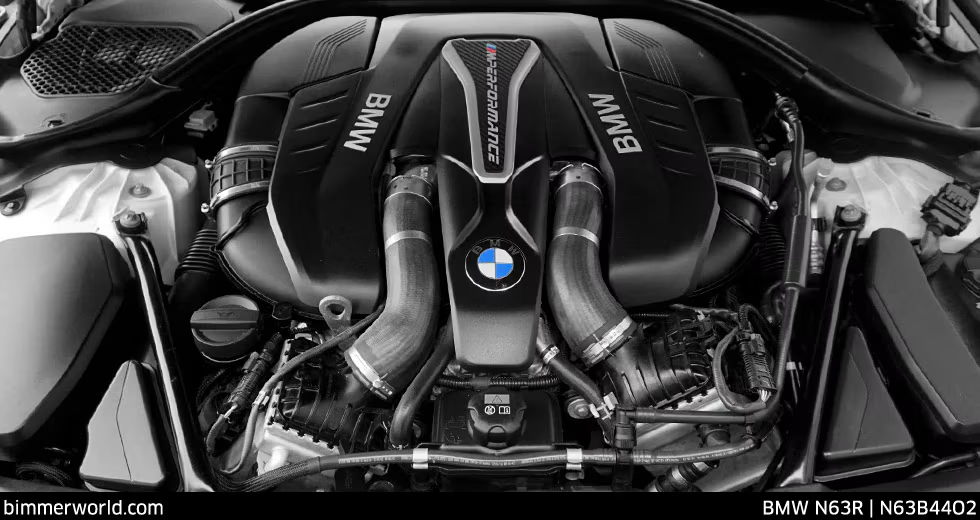
2016 N63B44O2 (N63TU2, N63R), 456hp/479ft-lbs
Mechanical revisions are minor and mostly aimed at lowering weight, improving cooling, and reducing complexity. Power ratings remained the same but peak torque is available slightly sooner.
- Twin-Scroll turbochargers added to the non-M N63 engine. This required other changes to the exhaust and cylinder head.
- Redesigned pistons with more oil drain reliefs, to allow more oil to drain back into the pan rather than be pulled up into the combustion chamber. This was one of the few hardware changes made to reduce oil consumption.
- Relocated engine oil cooler from the passenger wheel well to underneath the turbos in the hot-vee. The new heat exchanger piggybacks off the main cooling radiator and water pump. This not only simplified the cooling system but also deleted a radiator that did not function at low driving speeds anyway.
- A new 'half-shell" intake system with part of each intake manifold cast into the cylinder head. This reduced the number of fittings and seams that could cause pressure loss and made the overall packaging smaller, such as "using the N63TU2 engine for other vehicle projects" (BMW quote).
2016-2019 G12 750i
2017-2019 G30 M550i
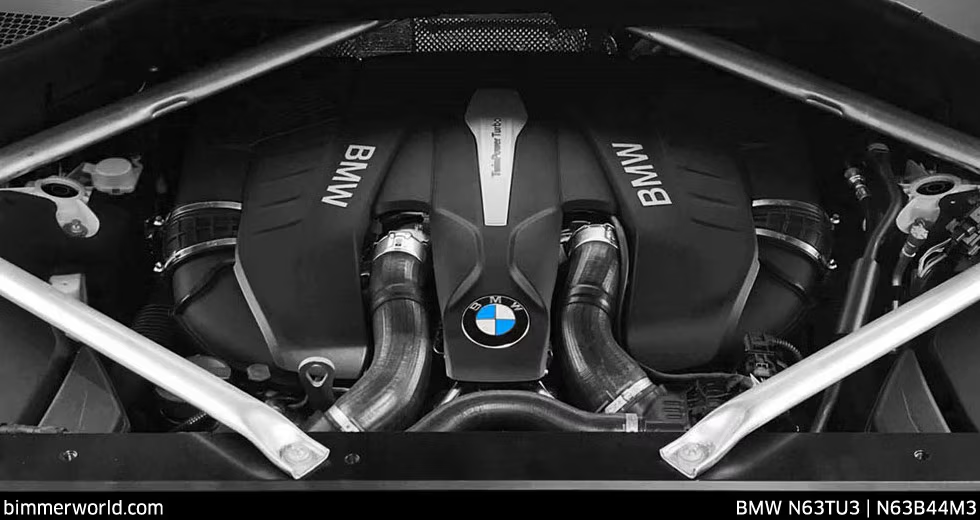
2018 N63B44M3 (N63M3, N63M), 456hp/479ft-lbs
"M" in this case refers to "medium output" for the engine and is found in "50i" models but not "M50i" models (see T3 below). The "M3" is an unfortunate coincidence with the 3-series model. Much of the M3 parts are carried over from the N63R design.
- The intercoolers now have a crossover tube between them (same as on F90 M5) that helps balance the pressure between both cylinder banks. Balancing the pressure avoids peaks and can provide a more stable air mass to set engine tuning.
- An HFM intake sensor is no longer used. Air mass is now calculated instead of measured via a series of sensors and tables (primarily Valvetronic position, intake pressure, and intake temperature) and further corrected by the oxygen sensors.
- The ignition coils on the N63M3 are the pencil type carried over from the N63R.
- The N63M3 version shares its turbo design with the N63O2 but now includes an overboost feature that allows an extra 34 horsepower for brief periods and only in Launch Mode.
2018+ G05 X5 50i
2018+ G07 X7 50i
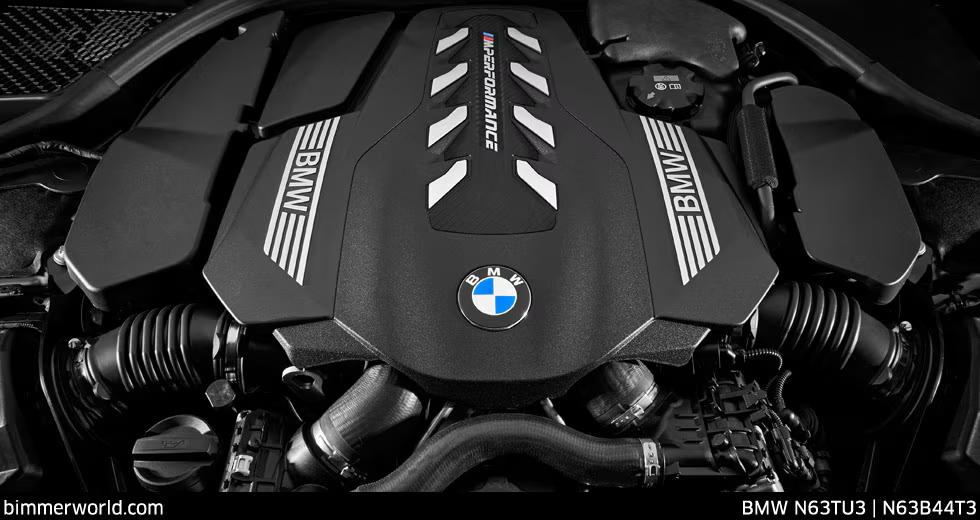
2018 N63B44T3 (N63T3, N63B), 523hp/553ft-lbs
The "T" is the "top" output class and is used in the M Performance models (not to be confused with M Performance accessories and parts). While the "M3" is an evolution of the N63R, the T3 has a broad mix of parts from various engines. BMW also gave this the unfortunate internal shorthand code of “N63B”, which you may catch is used in every BMW engine code as it denotes a gasoline engine (Benzene) so every N63 is technically an “N63B” even though they really mean this N63B refers to something else.
- The intercoolers now have a crossover tube between them (same as on F90 M5) that helps balance the pressure between both cylinder banks. Balancing the pressure avoids peaks and can provide a more stable air mass to set engine tuning.
- An HFM intake sensor is no longer used. Air mass is now calculated instead of measured via a series of sensors and tables (primarily Valvetronic position, intake pressure, and intake temperature) and further corrected by the oxygen sensors.
- The T3 ignition coils are a newer design similar to the latest B-series modular engines and ignition voltage is 50% higher. The T3 also gets different spark plugs.
- The T3 turbos are unique with diverter valves added back in (they were deleted with the introduction of Valvetronic on N63B44O1).
2020+ G30 M550i
2019+ G12 750i
2018+ G15 M850i
2020+ G05 X5 M50i
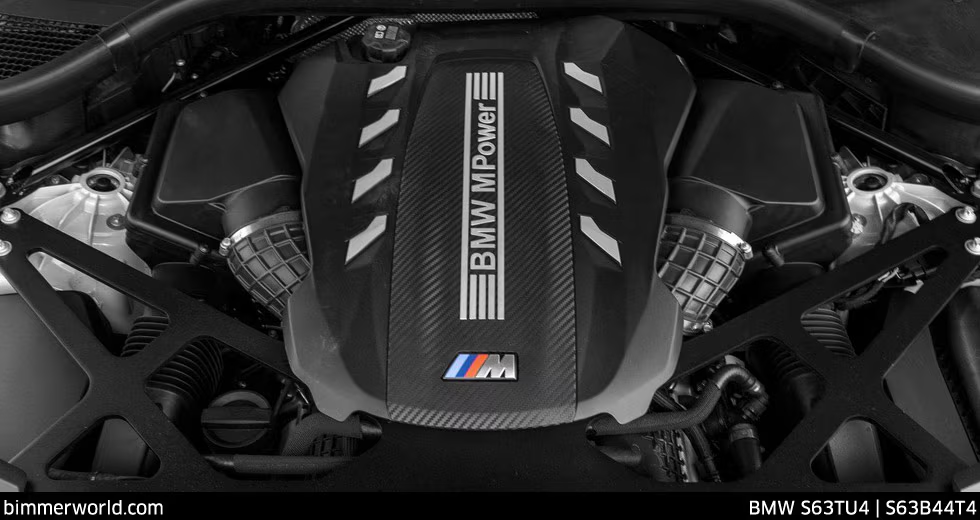
2018 S63B44T4, 600hp/553ft-lbs
BMW skipped a S63B44T3 designation. The T4 is largely based on the N63R used in the early G30 M550i with some extra M enhancements.
- Different piston design to match the M5's fuel strategy and pressure.
- "Half-shell" intake manifold design from the N63R engine.
- Elimination of the HFMs (as on N63T3).
- Twin-Scroll turbos are carried over the from S63T0 and T2 engines but re-optimized to match the updates of the N63R engine.
- Additional improvements have been made to the cooling system for the F90 compared to other S63 models.
2018+ F90 M5
2020+ F92 M8
2020+ F95 X5M
2020+F96 X6M
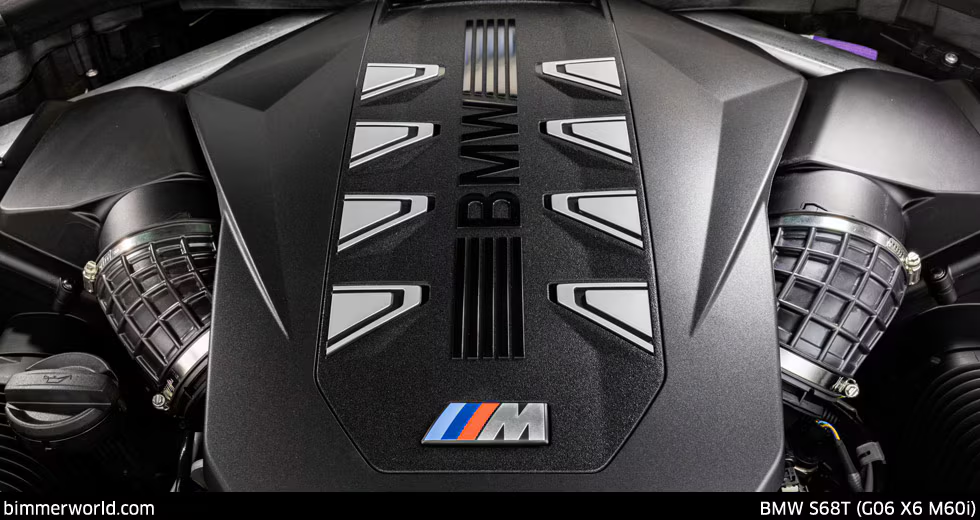
2022 S68B44T0
The S68 replaces the S63T4 and N63T3 engine variants in both standard models, M Performance models, and M GmbH models. It first appeared in the G70 760i and the G07 X7 M60i. The S68 is released as a “T” performance level, T = Top so we fully expect there to be S68M or S68O output variants and even S68T2 or other evolutions. It's still very early in the S68 lifespan.
The S68 has some radical evolutions from the earlier N63-based engines but enough new parts that it finally got a new engine code.
- Different piston design that further raises compression to 10.5:1.
- 48V mild hybrid system as seen as on other models.
- New ZF GA8HPTU3 8-speed auto
- Oil filter housing integrated into the upper oil pan.
- Map-controlled oil pump to boost pump output during high acceleration.
- Electric blow-off valves
2022+ G09 XM
2023+ G70 760i
2023+ G07 X7 M60i
2024+ G05 X5 M60i
2024+ G06 X6 M60i
2024+ F95 X5M Competition
2024+ F96 X6M Competition
2024+ G09 XM "Label Red"
N63/S63 Engine Problems
It was in 2015 when Road & Track magazine first put a spotlight on a major N63 defect: battery drain. That article (click here to view), was only the tip of the iceberg as more small and large problems began to reveal themselves. BMW stepped in early with a comprehensive Customer Care Package and extended warranties as well as made running changes during production to address flaws. The list below is in no particular order.
N63 Problem #1: Cracked Spark Plugs
Cracks may form on the ceramic insulator of the spark plug. This can cause misfires and rough engine running. This only appears to apply to one batch of plugs for cars made in mid-2009 but BMW was still advising inspection and replacement as late as 2014. If your engine has Bosch ZR5TPP339 spark plugs they should be replaced with the newer design, part # ZR5TPP330A (BMW part #12120040581). BMW had a service action to replace them free of charge. If you have misfires don't overlook the obvious!
N63 Problem #2: Battery Drain
Part of BMW's plan for better fuel efficiency involved shutting down alternator output, which saves fuel since the engine no longer has to expend any to spin the alternator. The system will reduce charging during normal driving and only run it during coasting (foot off the gas but not on the brake). However, BMW failed to consider American driving habits of being either on the gas or on the brake with very little coasting. Jumping right to the brake lowers RPM to idle where the alternator can't charge. The best and obvious solution is a software change to charge the battery more. However, that uses more gasoline, which means the car now gets worse fuel mileage and increased emissions (however slight it may be). That puts BMW in the crosshairs of the EPA and CARB for failing to meet fuel economy claims as well as opening them up to class action lawsuits for false or misleading advertising. The first remedy was to use larger and better AGM batteries that cope with extended periods without charging, and when that didn't work, replacing the battery altogether at every recommended oil change. And then further reduced the recommended oil change interval from 15,000 miles to 10,000 miles. So now N63 owners get a new battery at least once a year if it's serviced by the dealership.
N63 Problem #3: Oil Consumption
In the pre-turbo days it was normal for BMW engines to burn through a quart of oil every 1,000-1,500 miles. It's even more likely to consume oil with a turbocharged engine because the turbo itself requires oil for lubrication and cooling and some oil inevitably works its way into the turbo housing. Turbo engines also have more complex crankcase vent systems and the engine internals are under much more pressure. But N63 oil consumption is off the charts with reports of a quart every 400 miles!
The N63 oil consumption is a multi-faceted issue. A single defect is not the root cause. Instead, there are multiple failures and the N63 can suffer from more than one at the same time. Some are variant-specific but since the architecture of the engine is very similar there could likely be shared leaks without it being acknowledged. Here's a quick run-down of the official possibilities (found in BMW service docs):
- Crankcase Vent Hoses
- Valve Stem Seals in the cylinder head
- Turbocharger Oil Seals
- Turbocharger oil supply lines
- Piston Ring Sealing
- VANOS Actuators
- Oil Pump Control Valve seal ring
- Software Errors in the oil level sensor
- Normal Gasket Leaks
At first it was thought that improper engine break-in was the cause, leading to the piston rings not seating correctly and allowing oil through to the combustion chamber. But then came reports that the valve seals in the cylinder heads were machined too large which allowed oil into the combustion chamber from the top. BMW used the 10,000 mile oil change interval (see battery issue above) as a way of intercepting oil loss before the "Low Oil" message appeared on iDrive screens. It only cost them an extra oil change before the warranty expired. Eventually BMW released new valve guides with tighter clearances and offered a free replacement to existing owners. Replacing the valve guides is one of the more demanding and labor intensive jobs that can be done on any engine. Guides are buried in the cylinder head which requires removal of the camshafts, Valvetronic system, variable valve timing, timing chains, ignition system, and more. With 32 guides to replace, BMW techs spend over 11 hours on an N63 valve guide replacement.
N63 Problem #4: Timing Chain Stretch
There are two timing chains on the N63 - one for each cylinder bank. Timing chains include links that mesh with the gears at the top and bottom of the engine. The chain links do not stretch or lengthen over time. Rather the rollers (axles) of the chain suffer wear and that introduces play as the chain engages the sprocket. But it usually takes decades and hundreds of thousands of miles for the chain to need replacement. As early as 2014 BMW was seeing symptoms of timing chain wear: misfires and excessive rattling noises coming from the front of the engine. The sophisticated workshop diagnostic computer can actually measure how much wear is on the chain and technicians were instructed to run this test during the Customer Care Package. If the chains were found to be outside of normal spec they were replaced, along with the timing chain guides, rails, tensioners, and other hardware. The estimated time for this front end tear down and replacement is around 38 hours but some of the work is the same as replacing valve guides so at least there is some overlap.
N63 Problem #5: Auxiliary Water Pump
The electric aux water pump circulates coolant to the turbos after the engine is shut off. There are two different failures of N63 aux coolant pumps:
2008-2012 models: a crack inside the pump will allow coolant to leak onto the electronics. The pump simply stops working with no warning. There will be a iDrive error and fault code for the turbocharger coolant pump. There are multiple advisories and service campaigns on this for the earlier 2008-2012 N63 models so if your fault codes indicate the auxiliary turbocharger pump is malfunctioning it may be eligible for a free replacement. The 2013-2015 N63 engines got the updated part and are not part of any service action.
2016+ models: the 2016+ N63B44O2 used in the G30 M550i and G12 750i is also subject to a free replacement from BMW. The internal failure causes the pump to be blocked and coolant stops flowing to the turbochargers. The engine electronics detect the blockage and trigger the fault code. If the blockage is detected 1-2 times the pump is replaced. If three or more blockages are detected BMW may replace the turbochargers and the turbo cooling system.
N63 Problem #6: Fuel Injectors
Rough running and misfires can be caused by faulty fuel injector(s). The N63 uses the super high pressure Piezo fuel injection system that delivers fuel pressure at 200 bar (2,940 psi)! These injectors also have issues on the N54 inline-6 cylinder engines. BMW can use their diagnostic equipment to test each injector and make a recommendation for replacement of 1 or all 8 injectors. If the batch (index) number on the injector is 11 or below they will most likely be replaced.
N63 Problem #7: Fuel Pressure
Different than the fuel injector output listed above, the N63 has faults in its low and high pressure fuel systems.
N63 Problem #8: Oxygen Sensors
Oxygen sensors are normal wear items but they appear in the N63 service library quite often.
N63 Problem #9: Thermostat
The electronic thermostat on N63R engines used in G30 and G12 models can develop faults and malfunctions because coolant can leak past the internal seals and get into the electrical connector. The contamination in the connector will send error signals to the engine computer and throw fault codes. The thermostat may be functioning normally. In very extreme cases the coolant can travel along the wiring and reach the connector the engine computer. BMW recommends checking for coolant in the thermostat plug, wiring connector at the plug, as well as the connector at the computer. The presence of coolant will likely mean replacing the entire component. These models have a 15-year 150,000 mile warranty on the thermostat.
N63 Problem #10: Coolant Leaks for Charge Air Coolers
Early G30 and G12 models may be susceptible to internal corrosion of the front intercoolers, causing pressure to build inside each tank. The telltale of a problem is a coolant leak from the cap of the intercooler expansion tank (front center of the engine). The issue seems to only affect a limited range of G30 and G12 production. If coolant stains are present on the top of the expansion tank BMW will likely replace both charge air coolers. The warranty on these parts has been extended to 15 years / 150,000 miles.
S63TU Engine Oil Output Pump Shaft (O.O.P.S.)
This is an actual Recall and more than just a service action or parts bulletin (Recall Campaign 12V-475). The internal rotor for the pump can shear from the shaft. This will stop engine oil flow completely and likely cause complete engine failure. Fortunately, the affected vehicles are limited to cars built between July 2012 and September 2012, indicating this was a bad batch of oil pumps or improper assembly and not a design defect.
The N63 Customer Care Package
"A proactive package to update components on the N63 engine that will eliminate potential issues the customer may experience." This was a preemptive replacement of problem areas to stem the tide of failures and complaints. BMW's plan was to nail multiple problems at once and went to extraordinary lengths to accommodate customers. Parts to be replaced included: HFM air flow sensors, fuel injectors, vacuum pump, low pressure fuel system, turbo seals, and crankcase vent hoses.
The CCP was a separate initiative than the N63 engine replacement and other measures taken during the N63 class action lawsuit. The CCP was implemented in 2014 and the class action suit was settled in 2018. It's important to note that the CCP and the class action only apply to 2009-2014 models. Since BMW made ongoing changes to the N63 design, models from 2015 and later may not suffer from the same deficiencies as earlier models.
N63/S63 Main & Rod Bearings
With all of the internal engine work expected for an N63/S63 it may also be wise to replace the connecting rod and/or main crankshaft bearings. The rod bearings are straight-forward because there is only one option.
The main and thrust bearings are a confusing and convoluted process that probably requires direct consultation with your dealer. Main Bearings consist of an upper and a lower bearing shell. Upper goes into the crankcase and includes an oil groove; Lower goes into the main bearing cap. There are five main bearings with #3 being a thrust/guide bearing which is a different design but follows the same color and code logic. There are three shells for different clearances, coded by color: yellow, green, violet. BMW uses a laser-etched letter to indicate the color code. The crankcase code is on the outside of the passenger engine block. The lower code is on the first counterweight of the crankshaft. Both are an alphabetic code, A-Z (F, J, L, O, V, and Y are omitted). But there are only three color codes, 0-2. Locate the alphabetic code on the engine block and the code on the crankshaft.
A-H codes are the yellow bearing code.
I-R codes are the green bearing code.
S-Z codes are the violet bearing code.
There is a more extensive matrix table that BMW can provide you with to look up your bearing codes and colors.
This page is evolving and more will be added soon!
N63 Engine Products:
Note: since so many N63 engine parts are covered by one or more service bulletins we encourage you to check with your dealer before ordering parts. Your engine may benefit from one of these service bulletins and may get a new or updated part at no charge. Because of this we may not show all N63 parts that are available but contact us if you don't find what you're looking for.
| Sort by Name | Sort by Price |

